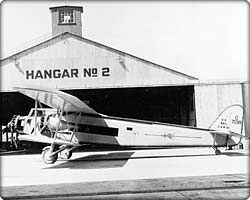Development and design
Boeing Air Transport was formed on February 17, 1927, by William Boeing to operate the Contract Air Mail (CAM) service between San Francisco and Chicago (CAM.18), taking over the route on July 1, 1927. [1] The route was initially operated by single-engined Boeing 40A biplanes, which could carry four passengers, which provided a useful supplement to the subsidized revenue from carrying airmail.
In order to take better advantage of passenger traffic, Boeing decided that it needed a larger aircraft that was more suitable for passenger carrying, and in early 1928 designed a trimotor aircraft capable of carrying 12 passengers, the Model 80. Unlike the Fokker F-10 and Ford Trimotors operated by other U.S. airlines, the Model 80 was a biplane, chosen to give good takeoff and landing performance when operating from difficult airfields on its routes, many of which were at relatively high altitude. The fuselage was of fabric covered steel and aluminium tube construction, and carried its 12 passengers in three-abreast seating in a well-appointed cabin. [3] [4] The flight crew of two sat in an enclosed flight deck forward of the passenger cabin. The wings were of fabric covered steel and duralumin construction, with detachable wingtips to aid storage in hangars. [3] [5]
The first Model 80, powered by three Pratt & Whitney Wasp radial engines, flew on July 27, 1928. [3] [4] It was followed by three more Model 80s before production switched to the improved Model 80A, which was longer, allowing 18 passengers to be carried, and was powered by more powerful Pratt & Whitney Hornet engines, first flying on July 18, 1929, [6] and receiving its airworthiness certificate on August 20, 1929. [7]
Operational history
The Model 80 carried out its first scheduled mail and passenger service for Boeing Air Transport on September 20, 1928, [4] and soon proved successful. [3] The improved Model 80A entered service in September 1929. [9]
In May 1930, Boeing Air Transport introduced female flight attendants, hiring eight including chief stewardess Ellen Church; all were unmarried registered nurses. Flights carrying stewardesses began on May 15. [10] The Model 80 and 80A remained in service with Boeing Air Transport (later renamed United Airlines) until replaced by the Boeing 247 twin-engined monoplane in 1934. [9]
This page is based on this
Wikipedia article Text is available under the
CC BY-SA 4.0 license; additional terms may apply.
Images, videos and audio are available under their respective licenses.


